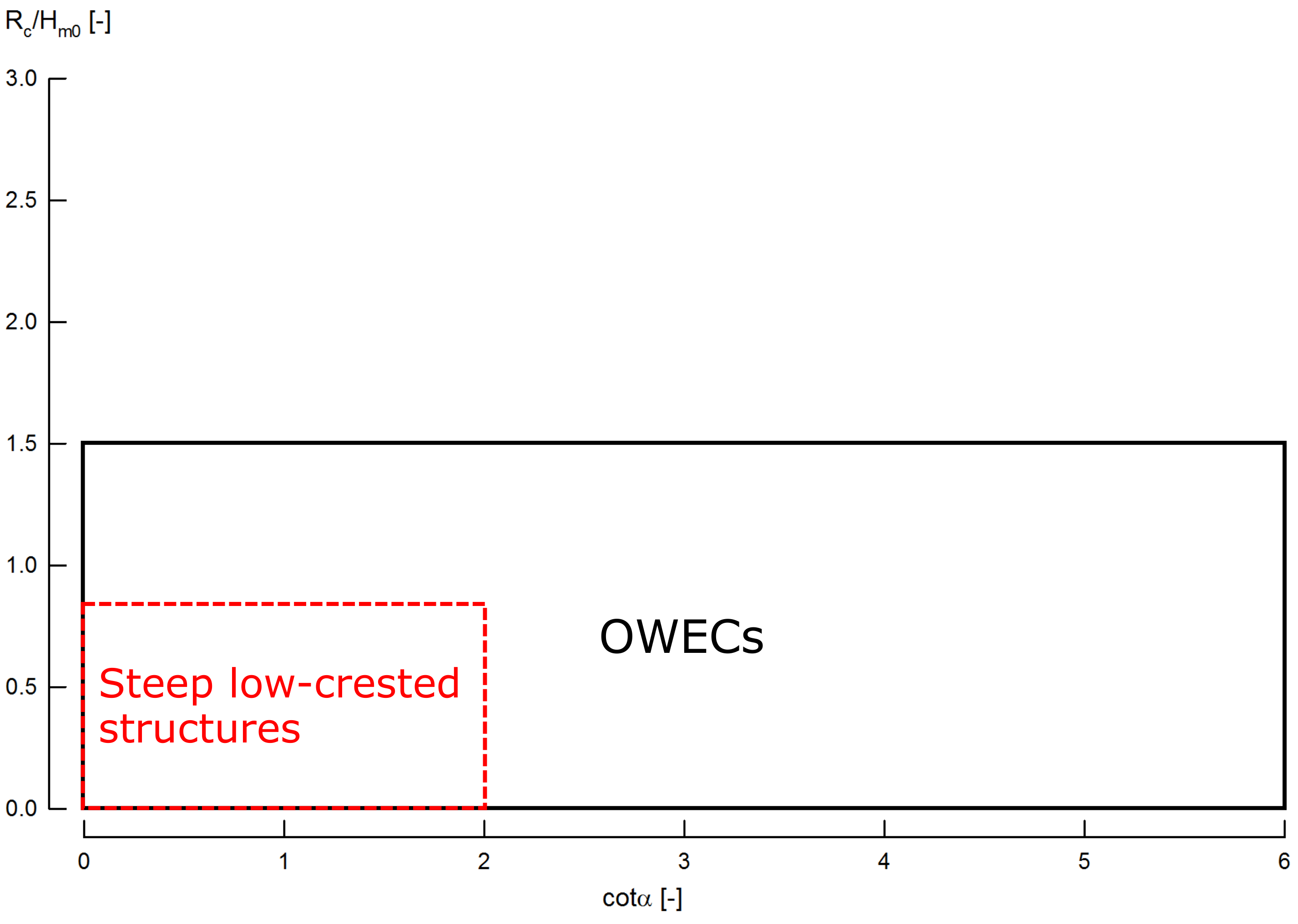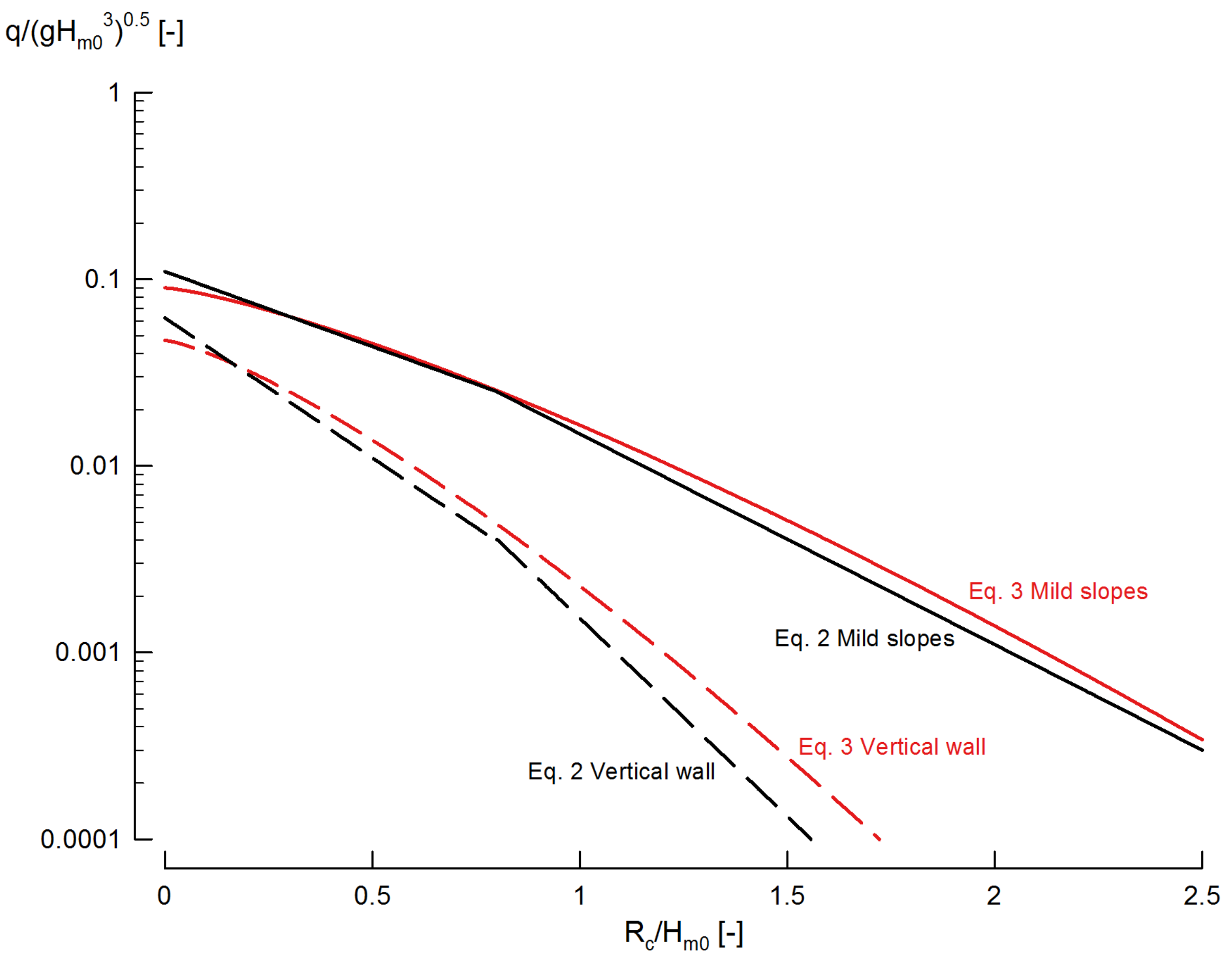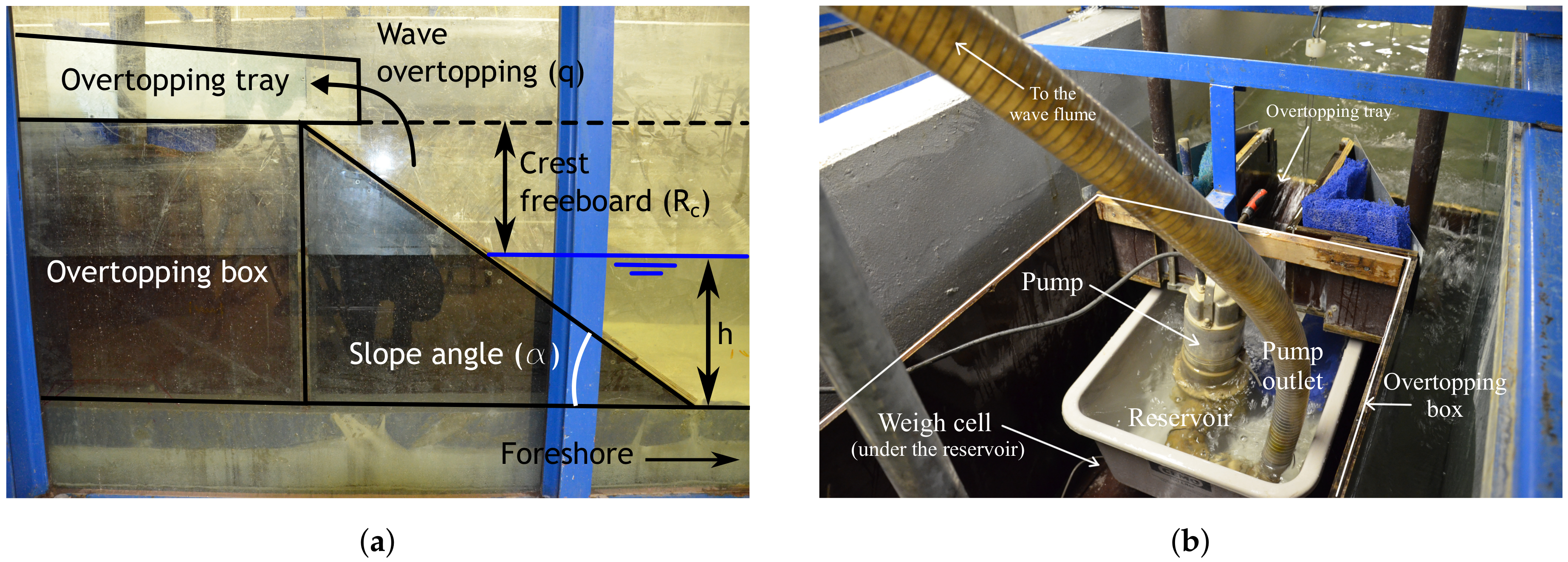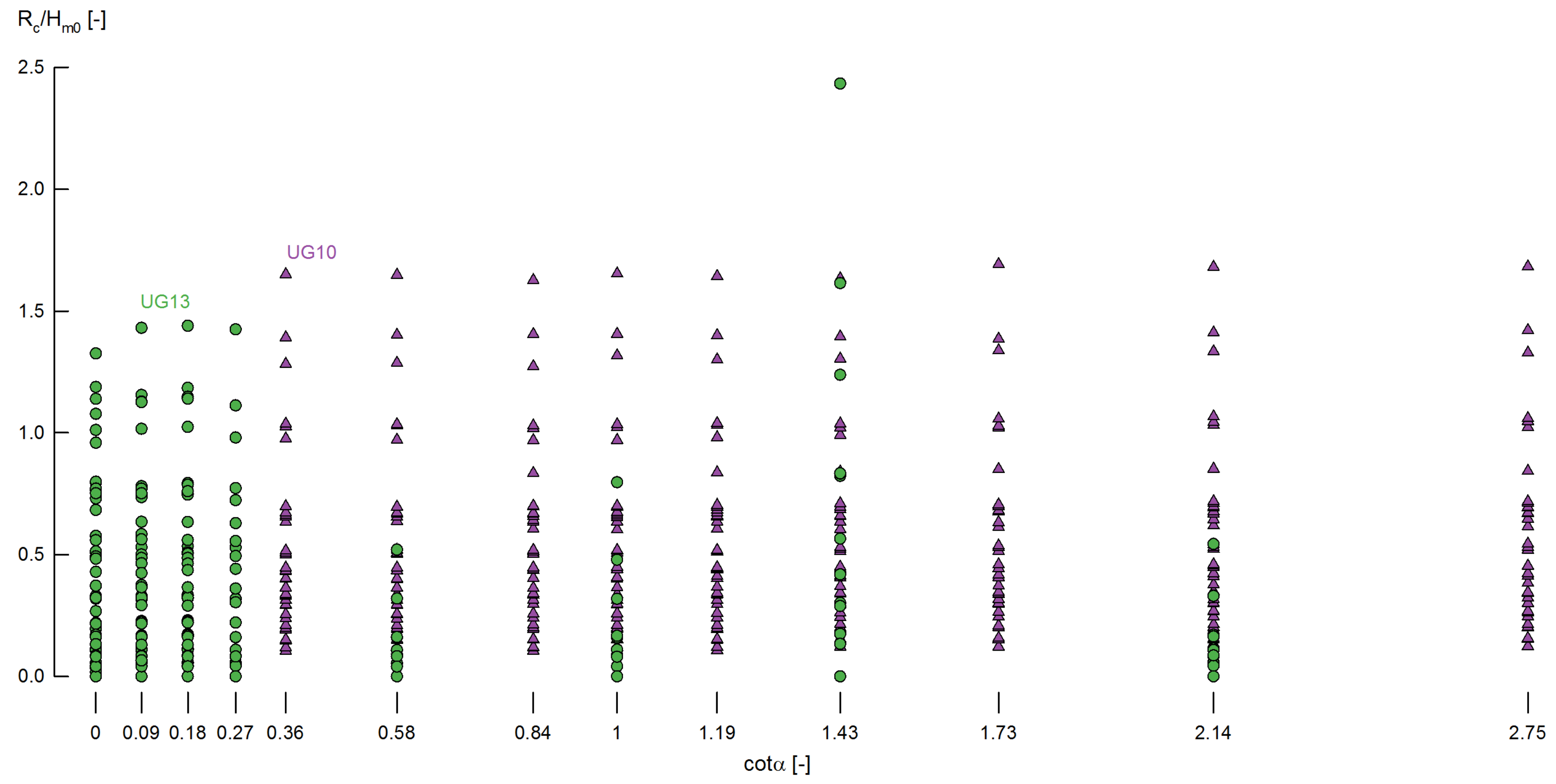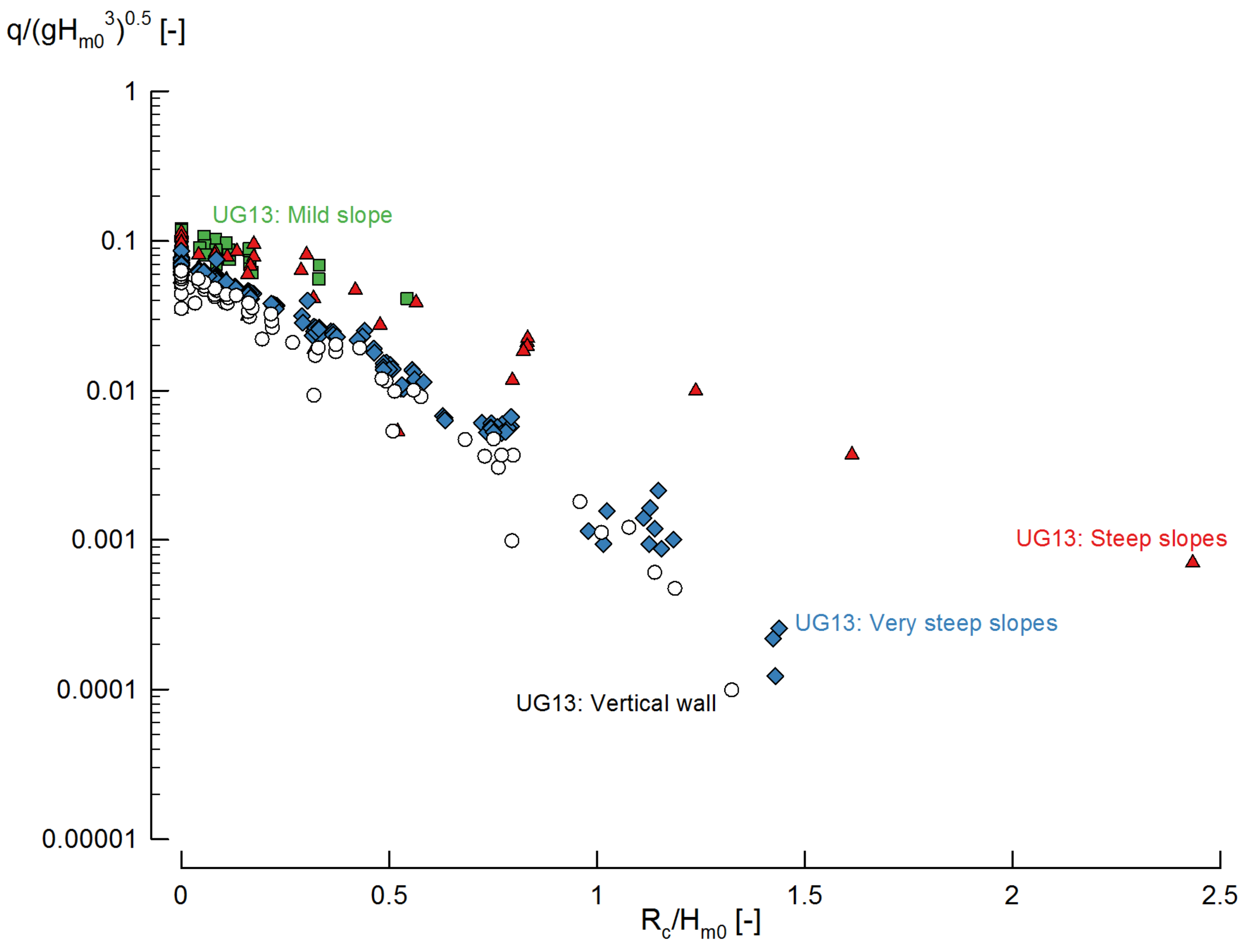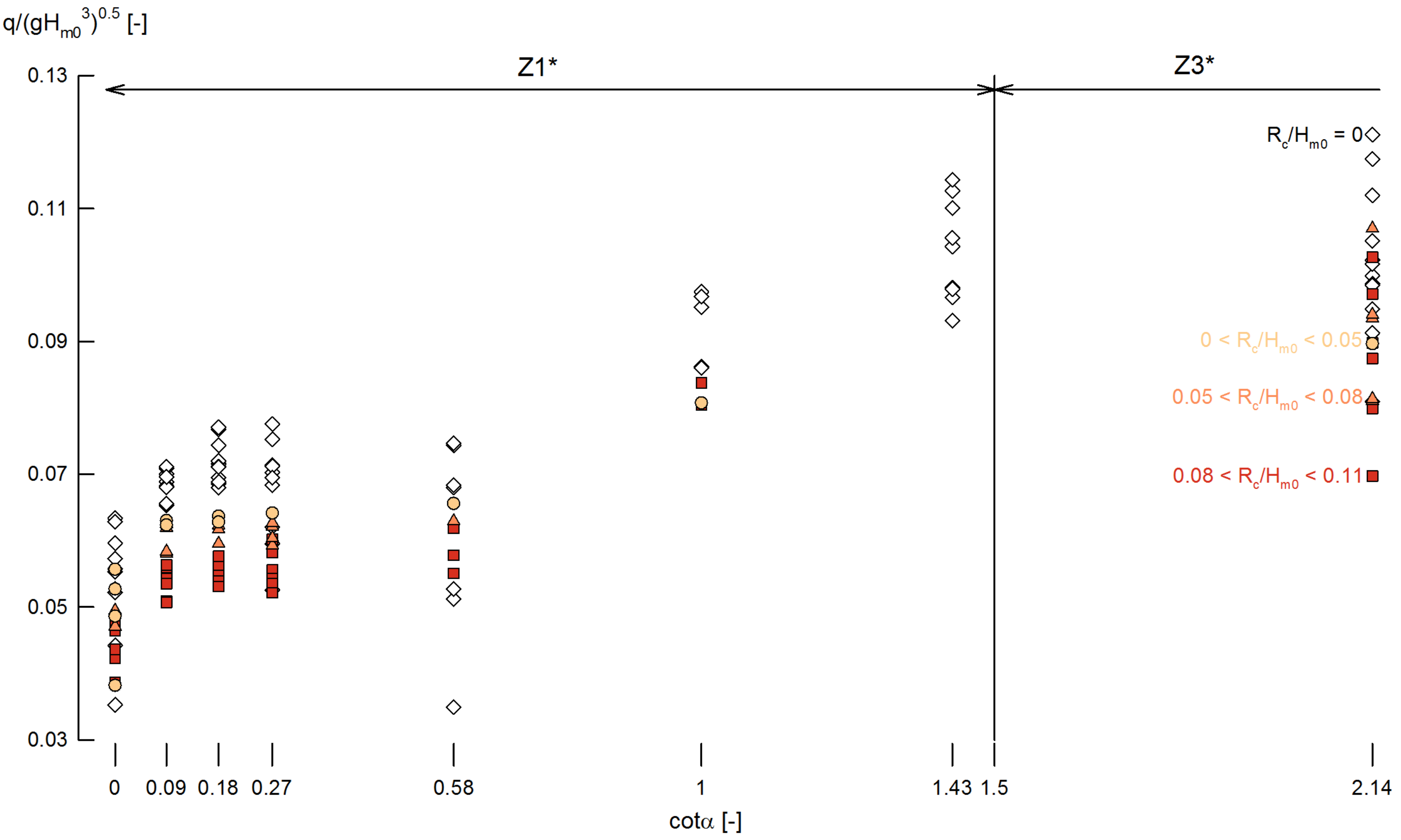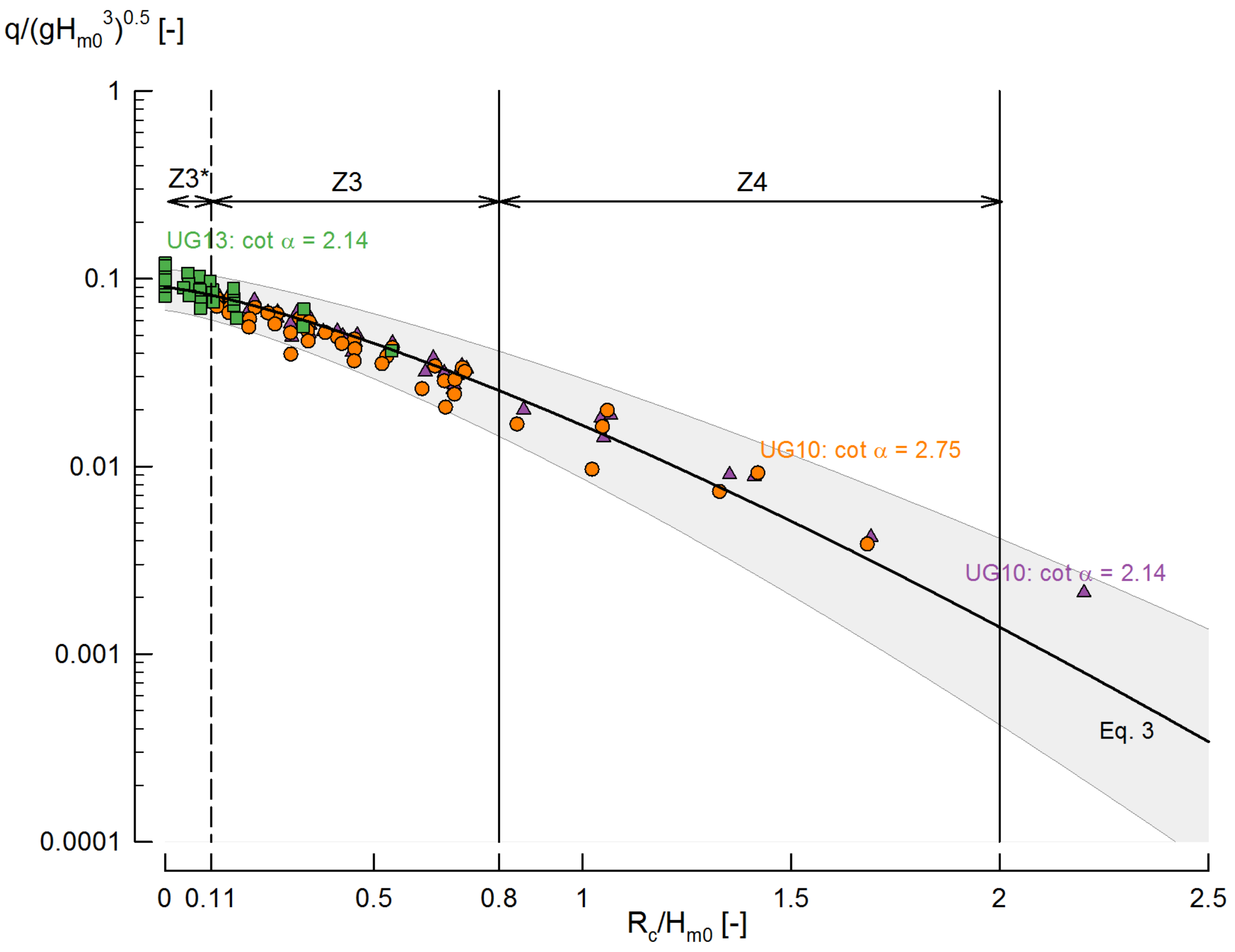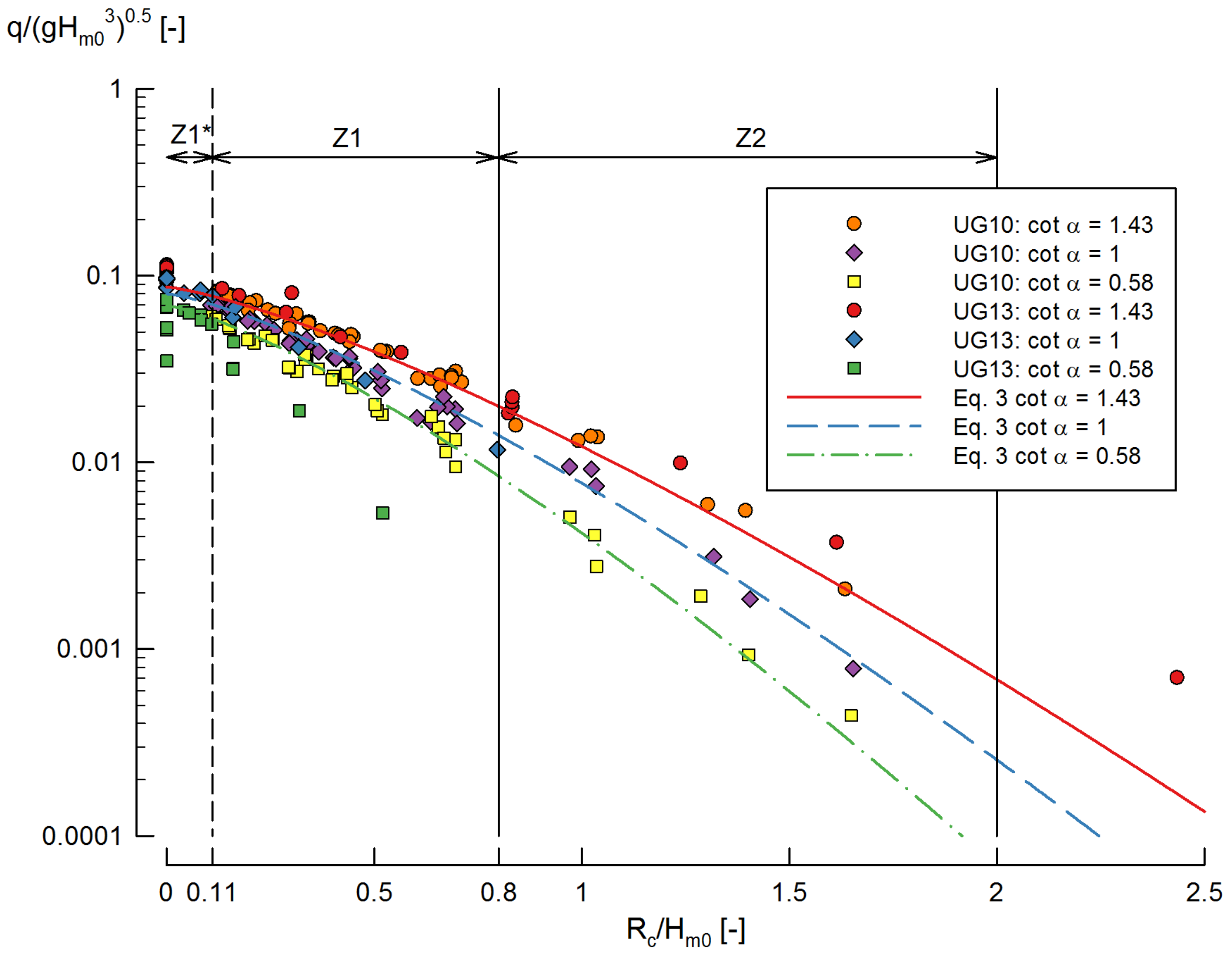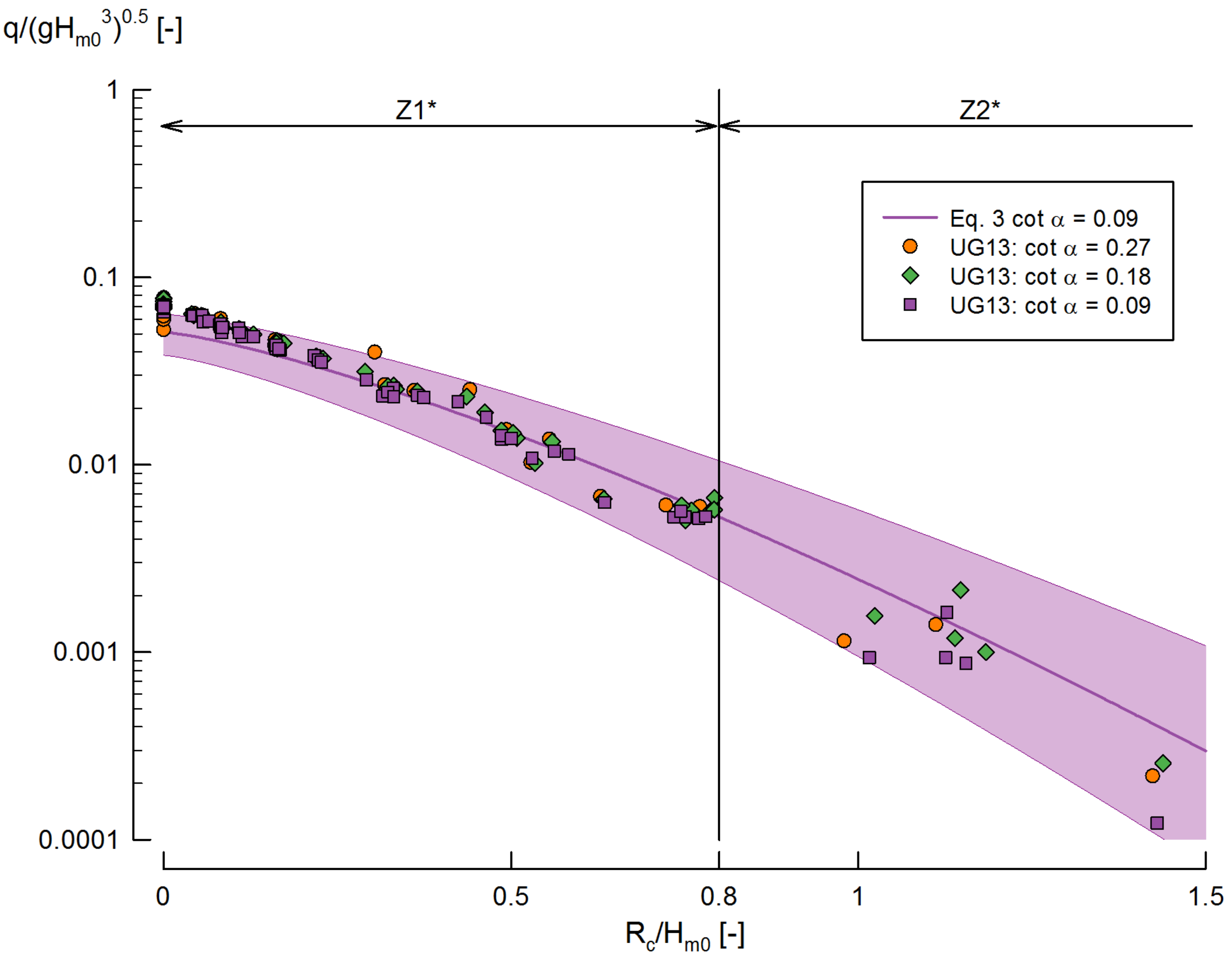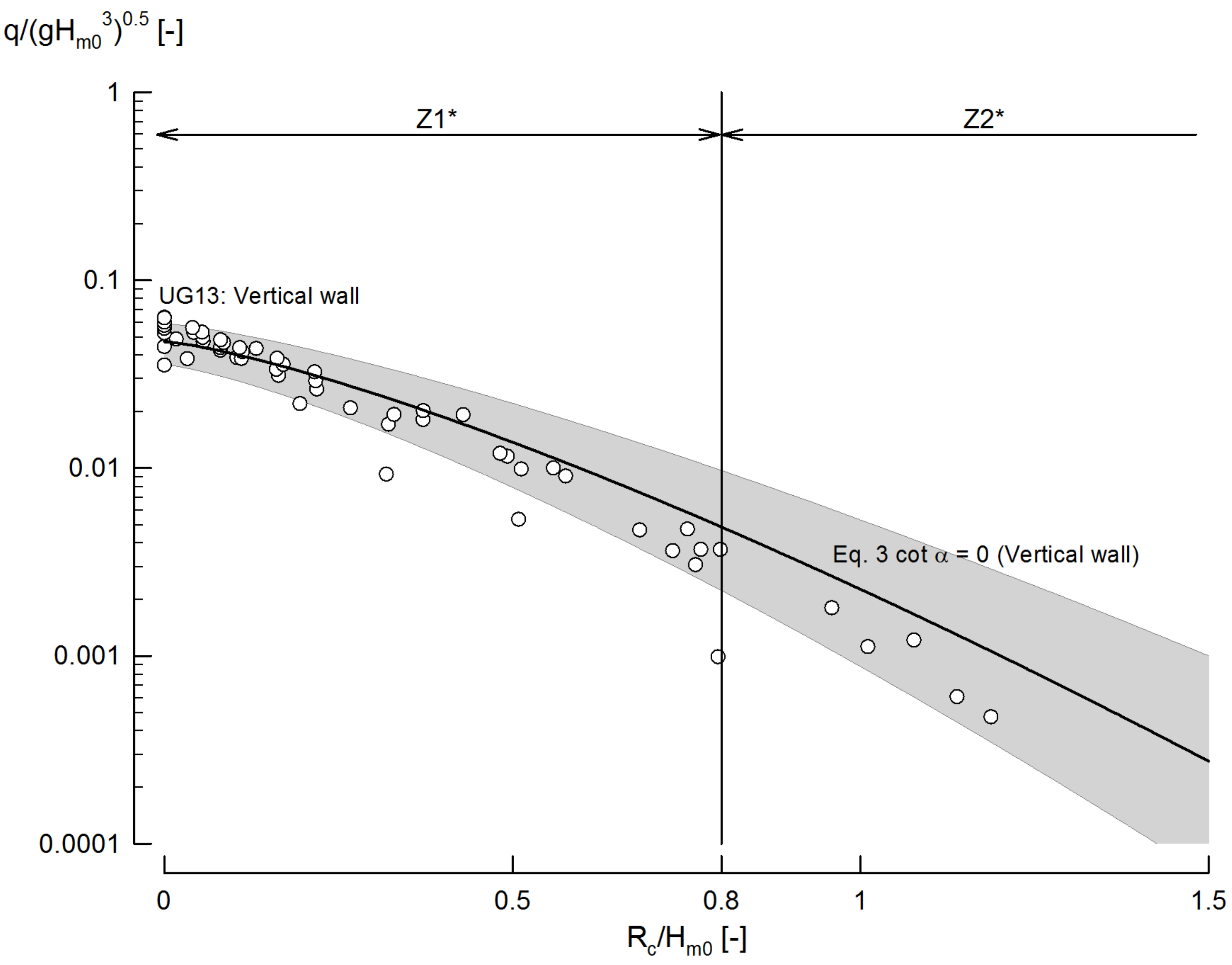2.2.1. Sloping Structures
The mean value approach of the average overtopping prediction formula for mild slopes in non-breaking conditions (Equation (
1)) contained in the EurOtop (2007) manual [
7] was originally presented by van der Meer and Janssen [
24].
In Equation (
1),
q is the average overtopping rate,
is the incident significant wave height at the toe of the structure,
is the crest freeboard, and
the slope angle of the structure. The parameters
and
are different reduction factors for the roughness of the slope and oblique wave attack, respectively. The coefficient
of Equation (
1) is a normally distributed stochastic parameter with an associated standard deviation of
. The range of application of Equation (
1) is for slope angles
between
and for relative crest freeboards
between
for surf similarity parameter values
. This range corresponds to the more conventional geometries (mild slopes with large relative crest freeboards), while for very steep slopes and vertical walls with very small and zero freeboards (i.e., steep low-crested structures) this formula should not be used.
The surf similarity paremeter is a dimensionless parameter that indicates the breaking wave type, and is defined by , which is the ratio between the tangent of the slope angle and the square root of the wave steepness . The different types of breaking waves derived from the surf similarity paremeter are spilling for , plunging for , collapsing for , and surging (non-breaking waves) for .
During the PhD research of Victor [
20] on OWECs, a new wave overtopping prediction formula was needed, which included the operational conditions of these devices that behave as low-crested structures. To fill the knowledge gap for overtopping on this type of structures, he obtained a new overtopping dataset for steep low-crested structures, the UG10 dataset (described in
Section 2.1). Victor and Troch [
10] developed new average overtopping prediction formulae (Equation (
2)) based on the dataset UG10, and the subsets 106 (small crest freeboards), 107 (zero crest freeboard) and 402 (large crest freeboards) of the CLASH database [
18] for plain vertical walls under non-impulsive conditions with relative crest freeboards
.
Equation (
2) shows the formula to predict the dimensionless average overtopping rate
and
Table 3 shows the expressions for the
a and
b coefficients as a function of the slope angle
and relative crest freeboard
. The formulae are divided into 4 different zones (Z1, Z2, Z3, Z4) depending on the values of slope angle
and relative crest freeboard
. This provides a high physical insight of wave overtopping, allowing a clear visualization of the physical meaning of the formulae and leading to a better understanding of the dependence of wave overtopping on the slope angle
and relative crest freeboard
. The formulae maintain the shape of the EurOtop (2007) formula for non-breaking conditions (Equation (
1)), with the relative crest freeboard
as governing parameter of the wave overtopping prediction. However, as opposed to Equation (
1), the overtopping prediction resulting from Equation (
2) is also influenced by the slope angle
.
For slopes
and (very) small relative crest freeboards
(zone Z1), the effect of the slope angle
on wave overtopping is significant, while for large relative crest freeboards
(zone Z2) this effect is even stronger than in the zone Z1. When considering slopes
, for both (very) small relative crest freeboards (
; zone Z3) and large relative crest freeboards (
; zone Z4) the effect of the slope angle
on wave overtopping is negligible and therefore not consider in the coefficients. The zone Z4 of this formula is equal to the EurOtop (2007) overtopping prediction formula for non-breaking wave conditions (Equation (
1)).
To obtain the 90% confidence band of the overtopping prediction, the authors apply an overtopping discharge factor based on the root mean square error (RMSE) of the tests through which the formulae were fitted. The overtopping discharge factor for the zone Z1 is 1.25; for the zone Z2 is 1.47; and for the zone Z3 is 1.18. To obtain the upper limit of 90% confidence band, the predicted overtopping value should be multiplied by the overtopping discharge factor; while to obtain the lower limit 90% confidence band, it should be divided by the overtopping discharge factor. The overtopping prediction in the zone Z4 is equal to Equation (
1) and therefore standard deviation
given with the equation is still valid.
The existing EurOtop (2007) [
7] wave overtopping prediction formula for non-breaking conditions (Equation (
1)) was reviewed and improved by the overtopping prediction formulae (mean value approach) presented by van der Meer and Bruce [
11], shown in Equations (
3)–(
6).
with the following expressions for the coefficients
a,
b and
c:
This prediction has an extended range of application with respect to Equation (
1) towards steep, very steep slopes and vertical walls (
), with very small and zero freeboard (
) for non-breaking conditions. For the range of validity of the EurOtop (2007) [
7] formula, Equation (
3) gives a similar prediction of average wave overtopping although providing a deeper insight of the overtopping process. The van der Meer and Bruce [
11] formulae is included in the EurOtop (2016) manual [
8] as the reference overtopping prediction for structures with steep slopes up to vertical walls with relative freeboards from large to zero. Compared to Equation (
1), the van der Meer and Bruce [
11] prediction formulae (Equation (
3)) add a power
(with a constant value) inside the exponential function (Equation (
6)) and two coefficients
and
which are a function of the slope angle
. The coefficient
(Equation (
4)) determines the overtopping value when the value of the x-axis
(where the y-axis is
) is equal to zero (therefore, in the case of zero relative crest freeboards
). The coefficient
(Equation (
5)) determines the shape of the equation for the entire range of
.
The reliability of Equation (
3) is described by a coefficient of variation
(being
the standard deviation and
the average value of normally distributed stochastic parameters) for the coefficients
and
, with the values
and
.
The expression for the
(Equation (
4)) and
(Equation (
5)) coefficients of Equation (
3) was fitted by van der Meer and Bruce [
11] using wave overtopping results for specific slope angles
and relative crest freeboards
from different sources (
Figure 2). For the mild slope range (
) the fit of the coefficients of the prediction formulae was performed through the UG10 dataset, the EurOtop (2007) [
7] dataset and the subsets 102 (with small crest freeboards) and 108 (with zero freeboard) of the CLASH database, taking these coefficients of the mild slope limit case as asymptotic values for steeper slopes with
. In the range of steep slopes (
) only the UG10 dataset results were used to fit the expressions of the coefficients, as the CLASH database lacks of overtopping data for this range of slopes. For very steep slopes (
) no data were used to fit the formulae, however the overtopping prediction is still considered valid, which raises concerns about the accuracy of the formulae on this range of slope angles. For the case of the vertical wall (
), the UG10 dataset also lacked of overtopping data. Therefore, the fit of the coefficients was performed through 9 subsets of the CLASH database for vertical walls (subsets 106 for small freeboards; 107 for zero freeboards; 113, 228, 229, 315, 351, 380 and 914), and the EurOtop (2007) [
7] dataset.
Figure 3 compares the Victor and Troch [
10] overtopping prediction formula (Equation (
2); black lines) with the van der Meer and Bruce [
11] formulae (Equation (
3); red lines) for the case of mild slopes
(solid lines) and vertical walls
(dashed lines). As seen both formulae give similar overtopping prediction, although Equation (
3) gives a slightly higher prediction for the case of vertical walls. The shape of the formulae are different even though they are both exponential. Equation (
2) are straight lines on a logarithmic plot while Equation (
3) are curved lines due to the coefficient that indicates the prediction follows a Weibull distribution. For very small and zero relative crest freeboards, Equation (
2) gives a higher overtopping prediction than Equation (
3). However, neither of the two formulae have been fitted with overtopping data in this range of relative crest freeboards and therefore the questions about the accuracy of the overtopping prediction arise.
